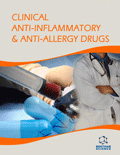- Home
- A-Z Publications
- Clinical Anti-Inflammatory & Anti-Allergy Drugs (Discontinued)
- Previous Issues
- Volume 1, Issue 2, 2014
Clinical Anti-Inflammatory & Anti-Allergy Drugs (Discontinued) - Volume 1, Issue 2, 2014
Volume 1, Issue 2, 2014
-
-
Interstitial Lung Disease Associated with Collagen Vascular Disease
More LessAuthors: Marco Antonio Solis Aramayo and Antonio Lopez LopezCollagen vascular diseases (CVDs), also known as connective tissue disorders (CTDs), include a diverse group of immunologically mediated inflammatory disorders. Systemic inflammatory response may affect many organs. Lung disease—especially interstitial lung disease (ILD)—is frequent in the course of rheumatological diseases and causes mortality and morbidity rates to increase. Since the overall incidence of I Read More
-
-
-
Pulmonary Hypertension in Idiopathic Pulmonary Fibrosis
More LessAuthors: Juan I. Enghelmayer, Tulio Papucci and Alejandro RaimondiIdiopathic pulmonary fibrosis (IPF) is a diffuse progressive parenchymal disease. Patients with IPF have a poor prognosis and frequently suffer from pulmonary hypertension (PH) complications, which are associated to significantly worse outcomes. In IPF, the pathogenesis of PH varies and has not been completely understood yet, since it may arise from multiple factors. In these patients, PH is associated with reduced exercise c Read More
-
-
-
Idiopathic Pulmonary Fibrosis: Treatment Strategies
More LessAuthors: Brenda E. Varela and Gabriela C. TabajIdiopathic Pulmonary Fibrosis (IPF) is a chronic, progressive condition of unknown etiology. Both the tomographic patterns and the pathologic anatomy correspond to usual interstitial pneumonia (UIP). Unfortunately, this is an irreversible disease with a variable clinical course that involves different phenotypes. Some patients are stable for a long time, while others present frequent acute exacerbations, or suffer a rapid decl Read More
-
-
-
Idiopathic Pulmonary Fibrosis, Opportunities and Challenges
More LessAuthors: Glenda Ernst, Borsini Eduardo and Salvado AlejandroIdiopathic Pulmonary Fibrosis (IPF) is a chronic, progressive and fatal disease. The average survival time has a range between 2 to 5 years, but the progression rate and the size of damage could result unpredictable. This fibrotic illness is limited to lung with low or absent inflammation. Recently, new therapeutic options have been described. Clinical trials were not powered to detect statistically significant differences in mortality; b Read More
-
-
-
Randomized, Placebo Controlled Study of the Effects of Etoricoxib on Markers of Inflammation, Pain and Muscle Force After Eccentric Exercise
More LessAuthors: Matthias Rother, Egbert Johannes Seidel, Ilka Rother and Steffen KollObjectives: Investigation of etoricoxib treatment on markers of inflammation, pain and muscle force after eccentric exercise. Methods: This randomized, placebocontrolled, double blinded, cross over study investigated 50 healthy subjects presenting pain during muscle contraction of ≥5 (range: 0-10) after two runs of eccentric exercise at 45 % of peak torque until volitional fatigue. Subjects were stratified into a young an Read More
-
-
-
Effect of Early Treatment of Newborns by Peroral Colonization Using Non-pathogenic E. coli on the Development of Their Immuno- allergic System
More LessIn our previous work, we presented the results of a 12-year study (1998-2010) from which we derived several important conclusions. This was a large cohort, in which were examined 3619 samples of umbilical cord blood. We reached several conclusions from which it was clear that allergy was significantly associated with a positive family history (statistical significance at 1 ‰). The first symptoms of allergic disease occurre Read More
-
-
-
Comparison of In Vitro and In Vivo Effects of Infliximab on Cytokine Production in Proliferating CD4+ T Cells in Patients with Rheumatoid Arthritis
More LessAuthors: Syuichi Koarada, Yuri Sadanaga, Natsumi Nagao, Satoko Tashiro, Rie Suematsu, Akihide Ohta and Yoshifumi TadaObjectives. To clarify in vitro and in vivo effects of tumor necrosis factor-alpha (TNF-alpha) blocker, infliximab, on cytokine production in proliferating CD4+ T cells in patients with rheumatoid arthritis (RA). Methods. Peripheral blood mononuclear cells (PBMCs), separated from patients with RA (n=22) and normal person (n=22), were labeled with CFSE [5 (and 6) carboxyfluorescein diacetate, succinimidyl ester], and cult Read More
-
-
-
Pharmacological Screening of Lantana camara for its Antiallergic Activity in Rodents
More LessAuthors: Manojkumar Mahajan, Vishal Gulecha and Chandrashekhar UpasaniThe study aimed to investigate antiallergic potential of methanol extract of aerial parts of Lantana camara L. (Verbenaceae) in animal models of allergy. The test extract (MLC) was screened for mentioned activity using compound 48/80 induced systemic anaphylaxis, mast cell degranulation, milk induced leukocytosis and eosinophilia in mice at different doses (100, 200 and 400 mg/kg, p.o.). Standard used in the study was diso Read More
-
Volumes & issues
Most Read This Month
Article
content/journals/caiaad
Journal
10
5
false
en


